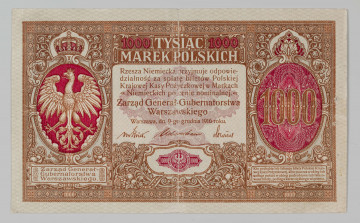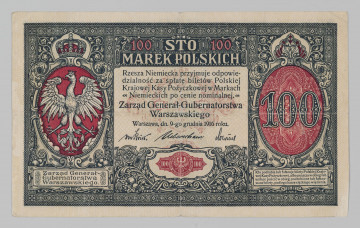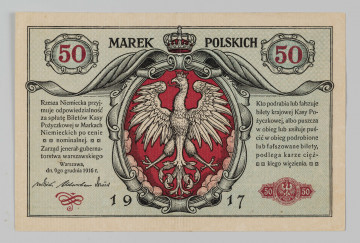
1000 Polish marks
1916
National Museum in Lublin
Part of the collection: Paper money during the Second Polish Republic
The resurgent Polish state in 1918 faced the challenge of rebuilding a country ruined by war and overcoming the legacy of bondage. Its remnants were the different legal, economic and financial-monetary systems of the Polish lands, which had operated in the partitioning states until then. Thus, when World War I ended, Ukrainian karbovanets, grivnas and vouchers issued by local authorities functioned alongside Austro-Hungarian, German and Russian money. The young state's complex political and economic situation did not allow the creation of a Polish Bank and a national currency. Therefore, it was decided that until that time, the function of a banking institution would be performed by the Polish National Loan Fund (Polish: Polska Krajowa Kasa Pożyczkowa, PKKP), established by the Germans, that issued Polish marks (Polish abbrev. mkp). The occupation issues of that institution did not lose their validity and were treated equally with the new marks. The dismissal of German staff from PKKP did not paralyse its operations. It was to the great credit of Director Zygmunt Chamec, who had been involved with PKKP since its inception.
First, the stocks of mkp, accumulated by the Germans, were put into circulation, and then the printing of new issues began. The 500 mkp banknote was the first paper money of independent Poland and was in circulation from 11 February 1919 to 1 January 1924. Its non-original graphic design, taken directly from the 100 mkp from the period of the German occupation, resulted from the need to save the time necessary to make the design and matrices.
Printed in the State Printing House in Vienna, the banknote is distinguished by rich floral ornamentation and an image of the White Eagle rising above the clouds, placed in a crowned oval shield on a red background. The characteristic feature of the ornamented reverse is the shields depicting the head of the goddess Minerva, patron of literature, art, knowledge and reason. Apart from the guilloche ornamentation, the security feature of the banknote was a watermark in the form of a mosaic, which was difficult to counterfeit.
The purchasing power of 500 mkp in early 1919 was the equivalent of a man's coat lined with fur.
Tomasz Markiewicz
Author / creator
Dimensions
cały obiekt: height: 198 mm, width: 121 mm
Object type
paper money
Technique
Material
paper
Creation time / dating
Creation / finding place
Owner
The National Museum in Lublin
Identification number
Location / status

1916
National Museum in Lublin

1916
National Museum in Lublin

1916
National Museum in Lublin
DISCOVER this TOPIC
Castle Museum in Łańcut
DISCOVER this PATH
Educational path